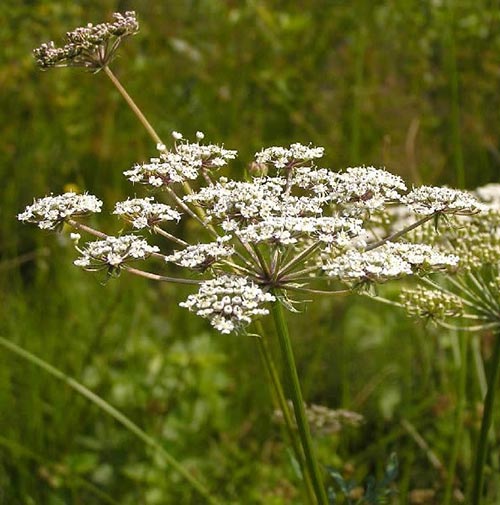Peucedanum caucasicum: Red Data Book of Armenia

VU B 1 ab(ii,iii,iv) + 2 ab(ii,iii,iv)
Category. Vulnerable species. It occurs in 2 floristic regions. The extent of occurrence is less than 20000 km2, the area of occupancy is less than 2000 km2. The species grows in the areas subjected to intensive economical activity. It was included in the first edition of the Red Data Book of Armenia under Category 2: Rare species. It is not included in the Annexes of CITES and that of the Bern Convention.
Description. Perennial herbs, 40–120 cm. Root collar covered with fibrose remnants of dead leaves. Terminal lobes of leaves broad, at base cuneate. Umbels 6–10–rayed. Bracts absent. Bracteolles of 2–3 setiform, congested on one side. Calyx teeth inconspicuous. Petals greenish–yellow. Fruits dorsally compressed; secondary vittae in valleculae solitary.
Distribution. In Armenia it grows in Idjevan (Gandzakar, Akhtala, Sevan mountain pass) and Zangezur (surroundings of Shurnukh village, Khustup Mountain) floristic regions. EOO is 6030 km2, AOO is 20 km2, the number of locations is 6. Besides Armenia it grows in Ciscaucasia, West and South Transcaucasia, Talish, Anatolia, North–West Iran.
Ecological, biological and phytocoenological peculiarities. Grows in middle mountain belt, at the altitudes of 1000–1800 meters above sea level, at forest edges, among shrubs. Flowering in July, fruiting from August to September.
Limiting factors. Restricted extent of occurrence and area of occupancy, severely fragmentation of the area of distribution, loss/degradation of habitats caused by land development for arable purposes, road construction, forestry activity.
Conservation actions. The part of the population grows in "Dilijan" National Park. Necessary: monitoring of the population state.
Suggestions
 The Ministry of Environment sent a letter international partners to draw their attention to the real danger of environmental disasters as a result of Azerbaijan's large-scale aggression towards the territory of Armenia
The Ministry of Environment sent a letter international partners to draw their attention to the real danger of environmental disasters as a result of Azerbaijan's large-scale aggression towards the territory of Armenia
 Vicia pisiformis: Red Data Book of Armenia
Vicia pisiformis: Red Data Book of Armenia
 Vavilovia formosa: Red Data Book of Armenia
Vavilovia formosa: Red Data Book of Armenia
 Trigonella capitata: Red Data Book of Armenia
Trigonella capitata: Red Data Book of Armenia
 Trigonella astroides: Red Data Book of Armenia
Trigonella astroides: Red Data Book of Armenia












